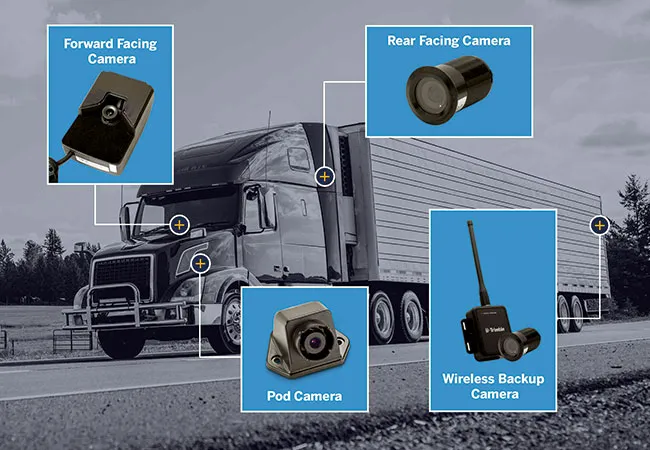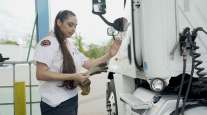Side, Rear Cameras Extend Visibility Around Tractor-Trailers

Vendors such as Trimble offer an array of cameras in and around the truck. (Trimble)
[Stay on top of transportation news: Get TTNews in your inbox.]
In addition to installing video-based safety systems in the cabs of their trucks, some fleet operators also are deploying cameras on the side of the truck and even rear cameras on the trailer to capture a more complete view of what is happening around the vehicle.
Considering these different options for camera configurations, fleets must decide the optimal number of camera systems for their tractor-trailers, choose optimal placement and determine at what point there is a diminishing return on the investment.
“In order of importance, road-facing is probably the most important, then driver-facing,” followed by sideview cameras, said Gary Falldin, senior director of industry solutions at Trimble. “It all paints a picture.”
He added, “We do have the ability to put a camera on the very back of a trailer. It’s not that common.”
The need to resolve questions of liability — “to protect themselves and exonerate the driver” — propels fleet interest in camera systems, Falldin said.
Deep Dive
►How AI Is Unlocking New Value From Onboard Cameras
►Side, Rear Cameras Extend Visibility Around Tractor-Trailers
►Fleets Can Earn Driver Acceptance of Video Safety Systems
For fleets that carry fuel or some type of hazardous material, camera systems can be used to confirm that drivers are wearing the proper personal protective equipment and following proper protocols.

Falldin
“That’s where side-facing and rear-facing cameras can see what the driver is doing in back,” including load securement on a flatbed, Falldin said.
He added that AI-enabled cameras can inform the back office whether standard procedures are being followed “and identify if there is a problem.”
Trimble also offers Driver Assist, a camera-based driver assistance feature that can be accessed on the same tablet that drivers use for electronic logging of their hours of service.
“If you’re backing, you can see the passenger-side view,” Falldin said. “The most common accident out there is the backing accident, even though they’re minor, usually [resulting in] no injuries. With Driver Assist, the driver can look at the tablet and see what’s going on.”
David Bell, CEO of CloneOps.ai, discusses the impact of AI on the trucking industry. Tune in above or by going to RoadSigns.ttnews.com.
Another provider of AI-enabled camera technology, Motive, has a partnership with Sentry Insurance. Users of the Motive systems get a discount from Sentry if they agree to share data from their Motive systems.
“Certainly from a claims perspective, the more views, the better off we are,” said Larry Harlow, director of claims for Sentry Insurance. “The more information that we’re able to gather, the better able we are to investigate the claim. The thing to remember is that the camera is one tool and one piece of evidence in a litany of things that we need to gather.”
Boyle Transportation and Skelton USA, sister companies owned by Andlauer Health Group, operate a combined 150 trucks, nearly all of which are over-the-road trucks fitted with forward-facing cameras and cameras on each side.
“We can see everything in front and alongside of our trucks, and we seem to do quite well with that,” said Michael Lasko, assistant general manager and vice president of environmental, health and safety and quality for both companies. “In my experience, the rear-facing camera on the back of the trailer is difficult to work into the fleet in a cost-effective way. We’re in a wait-and-see pattern.”
Want more news? Listen to today's daily briefing below or go here for more info:





